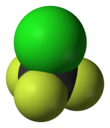Chlorotrifluoromethane
Appearance
| |||
| Names | |||
|---|---|---|---|
| Preferred IUPAC name
Chloro(trifluoro)methane | |||
| Other names
Chlorotrifluoromethane
Monochlorotrifluoromethane Trifluorochloromethane Trifluoromethyl chloride Trifluoromonochlorocarbon Arcton 3 Freon 13 Genetron 13 R-13 CFC 13 UN 1022 | |||
| Identifiers | |||
3D model (JSmol)
|
|||
| ChemSpider | |||
| ECHA InfoCard | 100.000.814 | ||
| EC Number |
| ||
PubChem CID
|
|||
| RTECS number |
| ||
| UNII | |||
CompTox Dashboard (EPA)
|
|||
| |||
| |||
| Properties | |||
| CClF3 | |||
| Molar mass | 104.46 g/mol | ||
| Appearance | Colorless gas with sweet odor | ||
| Density | 1.526 g/cm3 | ||
| Melting point | −181 °C (−293.8 °F; 92.1 K) | ||
| Boiling point | −81.5 °C (−114.7 °F; 191.7 K) | ||
| 0.009% at 25 °C (77 °F) | |||
| Vapor pressure | 3.263 MPa at 21 °C (70 °F) | ||
| Hazards | |||
| Occupational safety and health (OHS/OSH): | |||
Main hazards
|
Ozone depletor and asphyxiant | ||
| Flash point | Non-flammable | ||
| Safety data sheet (SDS) | ICSC 0420 | ||
Except where otherwise noted, data are given for materials in their standard state (at 25 °C [77 °F], 100 kPa).
| |||
Chlorotrifluoromethane, R-13, CFC-13, or Freon 13, is a non-flammable, non-corrosive chlorofluorocarbon (CFC) and also a mixed halomethane. It is used as a refrigerant, however, due to concerns about its ozone-depleting potential, its use has been phased out due to the Montreal Protocol.
Preparation
It can be prepared by reacting carbon tetrachloride with hydrogen fluoride in the presence of a catalytic amount of antimony pentachloride:
CCl4 + 3HF → CClF3 + 3HCl
This reaction can also produce trichlorofluoromethane (CCl3F), dichlorodifluoromethane (CCl2F2) and tetrafluoromethane (CF4).[1]
Physical properties
| Property | Value |
|---|---|
| Density (ρ) at -127.8 °C (liquid) | 1.603 g⋅cm−3 |
| Density (ρ) at boiling point (gas) | 6.94 kg⋅m−3 |
| Density (ρ) at 15 °C (gas) | 4.41 g⋅cm−3 |
| Triple point temperature (Tt) | |
| Critical temperature (Tc) | 28.8 °C (302 K) |
| Critical pressure (pc) | 3.86 MPa (38.6 bar) |
| Critical density (ρc) | 5.5 mol⋅L−1 |
| Latent heat of vaporization at boiling point | 149.85 kJ⋅kg−1 |
| Specific heat capacity at constant pressure (Cp) at -34.4 °C | 0.06 kJ⋅mol−1⋅K−1 |
| Specific heat capacity at constant volume (CV) at -34.4 °C | 0.051 kJ⋅mol−1⋅K−1 |
| Heat capacity ratio (к) at -34.4 °C | 1.168016 |
| Compressibility Factor (Z) at 15 °C | 0.9896 |
| Acentric factor (ω) | 0.17166 |
| Viscosity (η) at 0 °C (gas) | 13.3 mPa⋅s (0.0133 cP) |
| Viscosity (η) at 25 °C (gas) | 14.1 mPa⋅s (0.01440 cP) |
| Ozone depletion potential (ODP) | 1 (CCl3F = 1) |
| Global warming potential (GWP) | 14 000 (CO2 = 1) |
References
- ^ Greenwood, Norman N.; Earnshaw, Alan (1997). Chemistry of the Elements (2nd ed.). Butterworth-Heinemann. p. 304. ISBN 978-0-08-037941-8.


